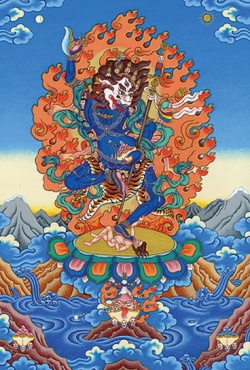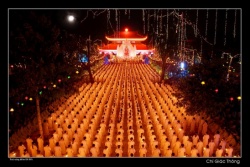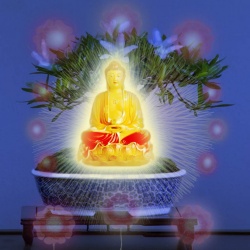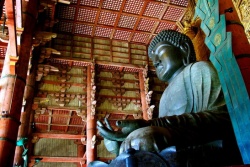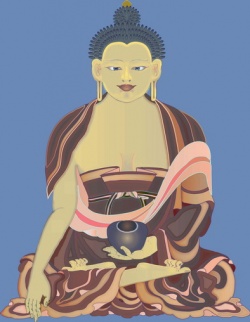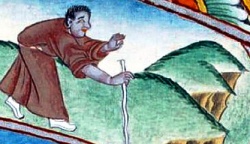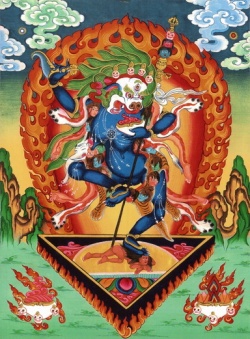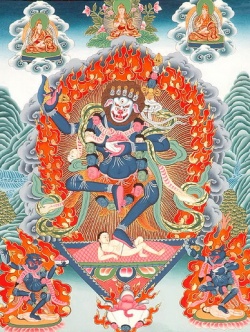Simhamukha
Click here to see other articles relating to word Simhamukha
According to Dilgo Khyentse Rinpoche, the original scriptural source for Simhamukha is the Drwa- ba’i sdom-pa’i rgyud.
This Tantra, where Simhamukha is linked with the eight wrathful Gauris (ke’u-ri-ma brgyad) and the eight Tramenmas or animal-headed sorceresses (phra-men-ma brgyad), appears to be connected with the Guhyagarbha Mayajala cycle (sGyu-‘phrul drwa-ba).
In the “Tibetan Book of the Dead” (Bar-do thos grol), these Gauri witches, representing the eight types of mundane Consciousness, and these eight animal-headed sorceresses, representing the eight objects of Consciousness, appear to the deceased Consciousness on the twelfth and thirteenth days of the Bardo experience after Death.
However, it is mainly through the Termas or hidden treasure texts discovered since the 11th century that Simhamukha is practiced among the Nyingmapas.
==Senge Dongma== (Skt. Siṃhamukhā)==
==The lion-faced dakini==
In the Nyingma terma tradition, she is considered as one of the many forms of Padmasambhava, specifically a secret form of Guru Rinpoche manifested to avert spiritual obstacles and negativity.
Simhamukha is a lion-head goddess. She is the punish er of animal abusers. She also rewards people who are kind to animals by sheltering them from bad luck and psychic attacks from angels and demons.
==May all beings know her protection, call to her when needed.==
According to the Sutra system, the practitioner takes Refuge in the Three Jewels of The Buddha, the Dharma, and The Sangha.
However, according the Tantra system one also takes Refuge in the Three Root of the Guru, the Deity, and the Dakini (bla-ma yi-dam mkha’-‘gro gsum).
In the Terma system of Jatson Nyingpo (‘Ja’-tshon snying-po, 1585-1656), known as the dKon-mchog spyi ‘dus, “The Union of all the Precious Ones,” the principal visualization practice is the Zhi drag seng gsum.
Here zhi; (zhi-ba); means “peaceful,” that is, the peaceful Form of Guru Padmasambhava known as Guru Zhiwa, dressed in his usual robes, holding in his right hand a golden Vajra before his Heart and in his left hand a Kapala containing a long-Life vase.
Drag; (drag-po); means “fierce,” and refers to the wrathful Form of Padmasambhava known as Guru Dragpo, who is flaming red in color, attired as a wrathful deity, holding a Vajra in his right hand and a black scorpion in his left.
==And senge means “lion,” and refers to the lion-headed Dakini Simhamukha (sen-ge’i gdong ma)
These three, invoked as a trinity, represent the Three Roots of Guru Deva and Dakini.
The famous Terton Ratna Lingpa (Ratna gling-pa, 1403-1479) also discovered many Termas relating to Simhamukha.
Similarly, the famous child prodigy Tulku Mingyur Dorge (Mi-‘gyur rdo-rje, 17th cen.), who received the gNam- chos or “sky teachings,” channeled certain hidden treasure texts pertaining to her.
Here and in other Termas there are presented different histories of how Padmasambhava received transmissions directly from his Dakini teacher in Uddiyana, Guhyajnana Dakini (gSang-ba ye-shes mkha’-‘gro- ma).
One of the eight manifestations of Padmasambhava (mtshan brgyad) is Simha-raurava (Seng- ge sgra-sgrogs),
“the roar of the lion,” which is linked with Simhamukha because Padmasambhava recived the transmission from Guhyajnana when he was in that guise.
As already said, Simhamukha is regarded as an emanation of this Dakini from Uddiyana.
==Because of the close link of Simhamukha with Padmasambhava, one could say she represents his Anima.==
According to the traditional history of the Seven Line Prayer (tshig bdun gsol ‘debs) of Padmasambhava, once an assembly of Buddhist scholars at Nalanda university debated with a group of Hindu scholars over certain matters of philosophy.
But the Buddhist scholars soon found themselves losing, and offered Puja to the Dakinis, praying for their help.
The melodious voices of the Dakinis prophesied that their brother, Padmasambhava, would come the next day to help them.
The next morning, a wild looking yogi from the Cremation ground nearby entered the hall and engaged the Hindu scholars in philosophical debate.
By the end of the day, he had systematically demolished all their arguments.
But many scholars remained obstinate, shouted insults at the yogi, and strode about the hall arrogantly.
The Guru sitting calmly amidst the storm raging about him, allowed a Thought of Anger to well up within him and then he projected the fiery energy of this wrath into the space before him.
It coalesced into the terrifying Form of the fiery lion-headed Goddess.
The haughty scholars were terrified at this manifestation and fled the hall. But the goddess pursued them, throwing them down of the ground.
Terrified the begged for their lives and submitted to the Guru and his teachings.
Despite her wrathful appearance and her magical activities, Simhamukha is a manifestation of the Enlightened awareness of The Buddha and her nature is Compassion.
She slays the dragon representing the forces of Evil and chaos. She only shows her fierce and angry face in order to subdue misguided beings, much like a mother disciplining her naughty child.
The worldly gods and spirits are not Enlightened beings; they are still conditioned by their Ignorance and their Karma and still abide inside of Samsara or cyclical existence.
And sometimes they direct negative energy against humans in the Form of maledictions and the practice of Simhamukha may be used to avert and repulse these psychic attacks.
Transcendent deities like Simhamukha are emanations or projections of Enlightened beings and being archetypes they may serve as Meditation deities.
These figures are principally classified into three types, because Meditation on them the serve as antidotes to the three principal poisons that afflict human Consciousness:
1. Meditation on peaceful tranquil deities transforms confusion,
2. Meditation on wrathful deities transforms Anger, and
3. Meditation on lustful or joyous deities transforms desire.
Where do the ornaments, attire, and attributes of a wrathful deity come from?
According to the Tantras, in prehistoric times on an island in the Indian ocean, Matam Rudra, a black sorcerer and demon king, threatened the very survival of the primitive human race.
Therefore, the Bodhisattvas Hayagriva and Vajravarahi gained entrance into his gigantic Body and blew him apart from the inside.
Thereupon, they donned his attire and ornaments and proceeded to subdue the lesser demons, terrifying them with their wrathful appearance.
==Simhamukha wears these same ornaments.==
As the Queen of the Night, she keeps at bay the nightmarish demonic entities who ever seek to invade our sunlight World of Consciousness from the twilight realms beyond.
As the active manifestation of Emptiness and Wisdom, her lion’s roar disperses discursive thoughts. And she is naked because she is equally devoid of discursive thoughts.
If the Great Goddess can be said to manifest herself in the three archetypes of Maiden, Mother, and Crone, Simhamukha represents the Crone aspect of feminine Wisdom.
She is the archetype of the destructive Terrible Mother, who destroys and yet regenerates all Life out of her cauldron.
All Phenomena dissolve into Shunyata or Emptiness, and again all Phenomena arise out of Shunyata.
==In the Tantras, one fights Fire with Fire.==
To those who are without Knowledge, Simhamukha is the demonic Terrible Mother, who threatens to devour her son, threatening his very existence.
What is more terrifying than the lion’s roar heard in the dark jungle in the middle of the night?
She represents the primordial fear of being killed and devoured by a savage beast.
It is the threat of annihilation. But to those who possess Knowledge, the lion-headed goddess is the very Form of Emptiness.
They have nothing to fear from the great void. She is the terrible lion-headed sentinel of time who stands at the portal, the active manifestation of primordial Wisdom, who destroys the notion of an unchanging permanent ego or substance.
In terms of the higher tantras, the deity of meditation (yi-dam lha), who is both wrathful and feminine, is dakini Simhamukha. It is important to understand that despite her very angry appearance and head of an animal, she is not a guardian spirit (srung-ma) who is magically subjugated, turned to the Dharma and bound by oaths of service to some powerful Mahasiddha in the past. Rather, she represents the
wrathful manifestation of the Guhyajnana Dakini, who, according to the Nyingma tradition, was Padmasambhava's chief teacher in the land of Oddiyana. Therefore, although Simhamukha is a dakini in her aspect, she functions as a yidam, or meditation deity, and her special functions
are to prevent and repel (bzlog-pa) psychic attacks that may plague the practitioner, and to pacify the negative feminine energies personified by the matrices. , or mom. These latter are wild uncontrollable female spirits that inhabit the wilderness, mountains and forests, beyond the borders of patriarchal civilization. These female spirits are usually hostile to the male sex.
Simhamukha appears in the wrathful female demonic form of mamo spirits because her wrathful aspect (khro gzugs) skillfully overcomes and subdues these violent negative energies. Simhamukha is the Jnana Dakini, or goddess of wisdom. According to Jigmed Lingpa (1726-1798), the famous Nyingma master and terma scholar, Simhamukha is the manifestation of the nirmanakaya appearing in time and history, while its
sambhogakaya aspect is Vajravarahi, and its dharmakaya aspect is Samantabhadri, the Primordial Wisdom itself. Very often the dakinis and matrikas were the old pre-Buddhist pagan goddesses of earth and sky, although usually the matrikas are always more localized.
Dakinis may appear in many different female forms, young and old, some with animal heads. In the Hindu tradition, the goddess Durga is
called the Queen of Dakinis and Matrikas, or witches. In many ways, Simhamukha represents the Buddhist version of Durga, but instead of riding a lion and swinging weapons in eighteen hands, Simhamukha has a lion's head. Among the eight sections of Tantra (sgrub-pa bka' brgyad) transmitted in Tibet in the 8th century by Padmasambhava, there is a section called "Ma-mo rbad gtong", "curse and spell associated
with witch goddesses", where Simhamukha as the main divine figure is very similar in its role to the goddess Durga in subjugating demons and evil spirits and protecting practitioners from negative provocations of energies emanating from mamo.
Like other nature spirits, mamo resent human destruction of the natural environment and therefore impose disasters, new diseases,
earthquakes, madness, wars and other ills on human civilization. The magical function of preventing psychic attacks As we have said, the main magical function of Simhamukha is to prevent or repel (bzlog-pa) the action of negative energy and send it back to its source, be it a black
magician or an evil spirit (gdon). This provocation of negative energy is called a curse (byad-ma, byad-kha) and is illustrated in the
story of Bari Lotsava (see below). As pointed out with the dakini Kurukulla, Tantric Buddhism sees working with energy in specific ways in terms of the four magical actions. Although Simhamukha can work with any of these four, it is predominantly associated with the four functions, or hard magical actions
(drag-po'i 'phrin-las). Therefore, the dark azure-blue Vajra Simhamukha is located in the center of the mandala. Spiritually it represents the transformation of anger or rage into enlightened consciousness.
She is surrounded by a retinue of four dakinis similar to herself, except for the color of their body and some attributes: in the east there is a white Simhamukha, she has a magical function of appeasing circumstances and healing, in the south there is a yellow Ratna Simhamukha, which has a magical function of increasing wealth and prosperity, in the west is the red Padma Simhamukha, which has the magical function of
charming and bringing others under its power, and in the north, the dark green Karma Simhamukha, which has the magical function of conquering and destroying negative forces. Each of these aspects of Simhamukha has its own mantras and rituals. If the practitioner is working on a particular
function, such as being successful in business or winning at horse races, he places Ratna Simhamukha in the center of the mandala while doing a visualization while repeating its action mantra.
But on thangkas Vajra Simhamukha is usually presented as the only figure, without an accompanying retinue.
Wrathful Archetype However, despite her wrathful appearance and magical actions, Simhamukha is a manifestation of the enlightened consciousness of the Buddha, and her nature is compassion. She only shows her fierce and angry face to tame misguided beings, much like a
mother disciplines her mischievous child. Worldly gods and spirits are not enlightened beings; they are still conditioned by their ignorance and their karma and are still inside sansara, or cyclic existence. And sometimes they direct negative energy against people in the form of curses, the practice of Simhamukhi can be used to prevent and repel these psychic attacks.
Transcendent deities such as Simhamukha are emanations or projections of enlightened beings and are archetypes that can serve as meditation deities. These figures are mainly classified into three types, since meditation on them serves as an antidote to the three main poisons that disturb the human consciousness.
1. Meditation on peaceful and calm deities transforms confusion.
2. Meditation on wrathful deities transforms anger.
3. Meditation on lustful or joyful deities transforms desires.
Where do the decorations, robes and attributes of an angry deity come from?
According to the Tantras, in prehistoric names in the Indian Ocean, Matam Rudra, the black sorcerer and king of demons, threatened the very survival of the primitive human race. Thus, the Bodhisattvas Hayagriva and Vajravarahi penetrated his gigantic body and tore it apart from the inside. Thereupon they put on his attire and ornaments and proceeded to subdue the lesser demons, terrifying them with their wrathful
appearance. Simhamukha wears the same ornaments. As Queen of the Night, she keeps at bay the nightmarish demonic entities that always seek to invade our conscious world of sunlight from the twilight realms beyond. As an active manifestation of emptiness and wisdom, her lion's roar dispels discursive thoughts. And it is naked because it is equally devoid of discursive thoughts. If the Great Goddess, as one might
say, manifests herself in the three archetypes of Maiden, Mother and Crone, Simhamukha represents the Crone aspect of feminine wisdom. She is the archetype of the destructive Terrible Mother who destroys and yet rebuilds all life from her cauldron. All phenomena dissolve into Shunyata or emptiness, and again all phenomena arise from Shunyata. In many ways, Simhamukha seems to correspond to the ancient Egyptian
lion-headed goddess Sekhmet, whose very name comes from the root "skhm", meaning strength, reminiscent of the Sanskrit word "Shakti".
Sekhmet represented the fiery energy of the sun, the energy of her father, the creator god Ra. But there has been a tendency in the
Western monotheistic tradition to repress the archetypal feminine. She was shielded by the male Heavenly God of the Biblical tradition. This
exclusively male deity can be tyrannical, vindictive and punitive, as well as kind, fatherly and forgiving. But in the Christian tradition, there was a tendency to see God as all-good, and therefore his dark side was projected onto the Devil, who was expelled from heaven and now dwelt underground.
This reflects the psychological process of denying evil within oneself and projecting it onto others. But in the tantras the individual fights fire with fire.
For those not in the know, Simhamukha is the demonic Terrible Mother who threatens to devour her son, threatening his very existence. She represents everything that men find most terrifying in women. What's scarier than hearing a lion roar in a dark jungle in the middle of the night? She represents the primordial fear of being killed and consumed by a wild female beast. This is the threat of annihilation. But for
those with knowledge, the lion-headed goddess is the very form of the void. They have nothing to fear from the great emptiness. She is the terrible lion-headed guardian of time (chronos leontocephalus) who stands at the gate, an active manifestation of the primordial wisdom that destroys the
notion of an immutable permanent ego or substance. Simhamukha According to the Nyingma Tradition According to Khyentse Rinpoche, the original source of the Simhamukha texts is Drwa-ba'i sdom-pa'i rgyud. This Tantra, where Simhamukha is associated with the
eight wrathful Gauris (ke'u-ri-ma brgyad) and the eight Tramenmas or animal-headed witches (phra-men-ma brgyad), seems to be related to the Guhyagarbha Mayajala cycle (sGyu-'phrul drwa-ba).
In the Tibetan Book of the Dead (Bar-do thos grol), these Gauri witches representing the eight types of mundane consciousness, and these eight animal-headed sorceresses, appear to the deceased consciousness on the twelfth and thirteenth days of the Bardo post-mortem
experience. However, it is mainly through termas discovered after the 11th century that Simhamukha is incorporated into the practice of the Nyingma followers. In the terma system of Jatson Nyingpo ('Ja'-tshon snying-po, 1585-1656), known as dKon-mchog spyi 'dus, "Union of All Jewels", the main
visualization practice is Zhi drag seng gsum. Here zhi (zhi-ba) means "peaceful", i.e. the peaceful form of Guru Padmasambhava, known as Guru Zhiwa, dressed in ordinary clothes, holding in his right hand a golden vajra in front of his heart, and in his left hand a chalice containing a vase of long life. Resistance (drag-po) means "fierce" and refers to Padmasambhava's wrathful form known as
Guru Dragpo, who is blazing red, dressed as an angry deity, holding a vajra in his right hand and a black scorpion in his left. And "seng" ismeans "lion", and refers to the lion-headed dakini Simhamukha (sen-ge'i gdong ma). These three, invoked as a trinity, represent the Three Roots Guru Dev and Dakinis. The famous Ratna Lingpa (Ratna gling-pa, 1403-1479) also discovered many termas relating to Simhamukha.
Similarly, the famous child prodigy Tulku Mingyur Dorje (Mi-'gyur rdo-rje, 17th cen), who received the gNam-chos, or "Teaching of the Heavens," revealed certain hidden precious texts relating to her. Here and in other terms, various stories are presented of how Padmasambhava received transmissions directly from his teacher in Oddiyana, Guhyajnana Dakini (gSang-ba ye-shes mkha’-‘gro-ma).
One of the eight manifestations of Padmasambhava (mtshan brgyad) is Simha-raurava (Seng-ge sgra-sgrogs), "the roar of a lion", which is associated with Simhamukha because Padmasambhava received transmission from Guhyajnana who was in this form. As I said, Simhamukha is seen as an emanation of this Dakini from Oddiyana. Due to the close relationship between Simhamukha and Padmasambhava, it can be said that she represents his Anima.
According to the traditional history of the Seven Line Prayer, at one time a gathering of Buddhist scholars at Nalanda University discussed certain points of philosophy with a group of Hindu scholars. But the Buddhist scholars soon lost their heads and offered puja to the dakinis, praying for help. In a melodious voice, the dakinis predicted that their brother Padmasambhava would come to help them the next
day. The next morning, a wild-looking yogi from a nearby cremation site came into the hall and engaged the Hindu scholars in a philosophical debate. By the end of the day, he had systematically destroyed all their arguments. But many scholars were stubborn, shouting insults at the
yogi and striding arrogantly around the hall. The Guru, who was sitting quietly in the midst of the storm raging around him, allowed the thought of anger to arise within him and then projected the fiery energy of that anger into the space in front of him. She rallied into the terrifying form of the fiery lion-headed goddess. The arrogant scholars were frightened by this appearance and left the hall. But the
goddess pursued them, throwing them to the ground. Frightened, they begged for their lives and submitted to the Guru and his teachings.
Simhamukha according to the Sakyapa tradition But the revelation of the root mantra for Simhamukha is especially associated with the name of Bari Lotsawa, who came from the Dringtsam region, and is said to have been born in the same year as Milarepa (1040). Traveling in Nepal and
India, he studied Sanskrit, translated many texts, including a collection of sadhanas and a collection of magical rituals. While in Nepal, he argued with a Hindu teacher named Bhavyaraja, and when he later won, the sorcerer launched a magical attack against the interpreter.
Terrified, he fled to Bodhgaya in India, where his own spiritual master, Vajrasanapa, advised him to propitiate the Dakini with puja offerings and pray for help. Simhamukha appeared to him in a dream and told him to go to a large rock east of Bodhgaya and dig below the rock where he would find a coffin. He followed her instructions exactly and found the coffin as described. Inside, written in blood on human
skin, was a ferocious fourteen-letter mantra that prevents all magical attacks (sngags drag zlog yi-ge bcu-bzhi-pa). That night, he performed a rite of prevention (zlog-pa byas-pa) and, using a mantra, he succeeded in throwing all the negative energy attacking him back to his source in Nepal. The recoil was so strong that it killed the sorcerer.
During the next year, Bari performed penitential and purificatory practices in a stupa in Bodhgaya to purify the sin of his act. Returning to Tibet, he provided the practice of Simhamukha Sachen Kunga Nyingpo (Sa-chen kun-dga’ snying-po, 1092-1158), both oral instructions and
magical rituals [29]. Thus the prescriptions for the practice of Simhamukha from Bari Lotsava became one of the Thirteen Golden Dharmas (gser chos lugs) of the Sakya tradition. These teachings came from Khyentse Rinpoche, who was himself a Sakyapa lama. In the 17th century, there was an important master belonging to the Bodongpa line, Togdan Namkha Sangye Gonpo (Nam-mkha’ snags-rgyas mgon-po), but following the
tradition of Bari Lotsawa when he practiced Simhamukhi. He was called Togden (Togdan, rtogs-ldan), which literally means "one who has understanding", as he was a wandering yogi. He was cured of leprosy due to the vision of Simhamukha. But later he also had personal contact with Guru Rinpoche in his pure visions and was instructed in the practice of Simhamukha according to the system of Anuyoga, the instantaneous generation of a deity. Sangye Gonpo explained that at the end of the practice one should integrate into the state of
contemplation, which is the Great Perfection or Dzogchen. This is very different from the usual practice of Simhamukhi in the Sakya and Gelug traditions (which later inherited it). The most extensive Tibetan commentary on the practice of Simhamukha was given by Jamyang Khyentse Wangpo (1820-1892). This text draws on the Nyingma tradition where the Dakini is associated with Padmasambhava, and the traditions of the New Schools, especially the Sakya and Bodong.
The text is titled "Excellent Jewel Vase" (Rin-chen bum bzang). A number of sadhanas and magical rituals associated with Simhamukha can be found here, as well as a history of the unfolding of practices associated with Bari Lotsawa and Sangye Gonpo. The text compiled by the first Khyentse Rinpoche is based on the teachings of Sangye Gonpo, but before that Khyentse collected many different texts and brought them
together in one volume. Khyentse Rinpoche gives three sadhanas for the outer, inner and secret forms of Simhamukha, compiled by Padma Gargyi Wangchuk (Padma gar gyi dbang-phyug), also known as Jamgon Kongtrul (‘Jam-mgon kong-sprul, 1813-1899). He was Khyentse's colleague in the non-sectarian Rime movement in Eastern Tibet in the 19th century. The outer sadhana (phyi sgrub) is the Vajra Dakini Simhamukha, which is
the usual form depicted on a thangka (described below). The inner sadhana (nang sgrub) is for Padma Dakini Simhamukhi, who has a red body and a yellow lion face. It serves to increase wealth and charm. The secret sadhana (gsang sgrub) is the extremely wrathful black Krodha Kali Simhamukha (khros-ma nga-mo), the "wrathful black goddess" who appears to destroy the illusion of ego symbolized by the insatiable demon king Rudra, just as Durga cuts the head of the demon king Mahisha.
The secret sadhana is also associated with the practice of Chod (gcod), chopping off or cutting off the ego. For this reason, this form of Simhamukha is also called Vajra Nairatmya (rDo-rje bdag-med-ma), "that which destroys the ego." In general, the ritual practice of Simhamukha proceeds in the usual form of dakini sadhana and puja, as, for example, with Vajrayogini. The practitioner places a chalice
filled with wine on a tripod in the center of the mandala in the sanctuary. A metal mirror is placed across the skull bowl. This mirror is covered with red Sindhura powder, on which crossed triangles of generation are drawn in the form of a hexagram. This symbol is called Dharmodaya, or the source of all phenomena, and in its center is drawn the letter HUM, which is the syllable-seed of the wrathful goddess. A vase with consecrated water is placed under the tripod. The vase, kapala, and Dharmodaya are all standard feminine symbols. Around them are various offerings and ritual accessories.
Description of Dakini Simhamukhi In Jamgon Kongtrul's Vajra Dakini Simhamukha sadhana, the goddess is described as follows: “The color of her body is dark azure, like the dark color of gathering thunderclouds. And she is extremely angry. She has one face and two arms. Her leonine face is white and turned slightly to the right. The expression on her face is fierce and angry. Lightning flashes from her three red
eyes, and the lion's roar is like thunder. The hair on her head is long, black and made of iron. From the mass of hair that billows like a storm, miniature phurpas fly out like living sparks. In her right hand, a five-pointed vajra blooms in the sky, and her left hand holds a
kapala, a skull-cup filled with blood, in front of her heart. She has a khatwang staff on the crook of her left arm. She girds her waist with a skirt made of tiger skin, and wears an elephant skin and skinned human skin as a mantle. In all respects she is clothed in the eight-fold garment of cremation ground. She adorns herself with a long garland of dried and freshly severed human heads, as well as necklaces of
human bones. She is adorned with various kinds of terrible phenomena, and in her navel are the sun and moon. Her two legs are extended and spread apart in the ardhaparyanka dance position as she stands in the midst of the blazing masses of the flames of wisdom. She has a white OM on her forehead, a red AH on her throat, and a blue HUM on her heart. Then from the syllable HUM at the center of her heart beams of light emanate, and from the great furious cremation ground in the country of Oddiyana, which is in the western direction, the Jnana Dakini Simhamukha is invoked, who is surrounded by a retinue of hundreds of thousands of terrible Matrik goddesses, along with an ocean-like host
of guardian spirits. who are her servants." Thus, Dakinis, in a Buddhist context, represent the rebirth of the feminine on all levels, in the realms of the physical and the spiritual, not just as additions to the male deity, but as an independent force in its own right.
According to the anuttara tantras, on the occasion of the third or wise initiation, when the Guru accompanies the candidate from the entrance of the eastern gate to the center of the mandala itself, he comes face to face with Wisdom in the form of a Dakini. Without this integration with the
feminine, the human psyche cannot become whole or enlightened. Historically, Western consciousness has tended to
repress and exclude from heaven the realms of the spiritual, both the feminine and the shadow side of things. However, in the Tibetan Buddhism of medieval India and Tibet, especially in High Tantra, we find an interesting process of reintegration of both the feminine and
the shadow side, back into the manda.lu of the psyche, not as secondary or non-essential figures on the periphery, but as central to the mandala and as direct manifestations of enlightened consciousness. The method used here is alchemy, a process of transformation (‘gyur lam) where negative emotions are not denied, but their energy is accepted and transformed into enlightened consciousness in the form of a meditative deity.
